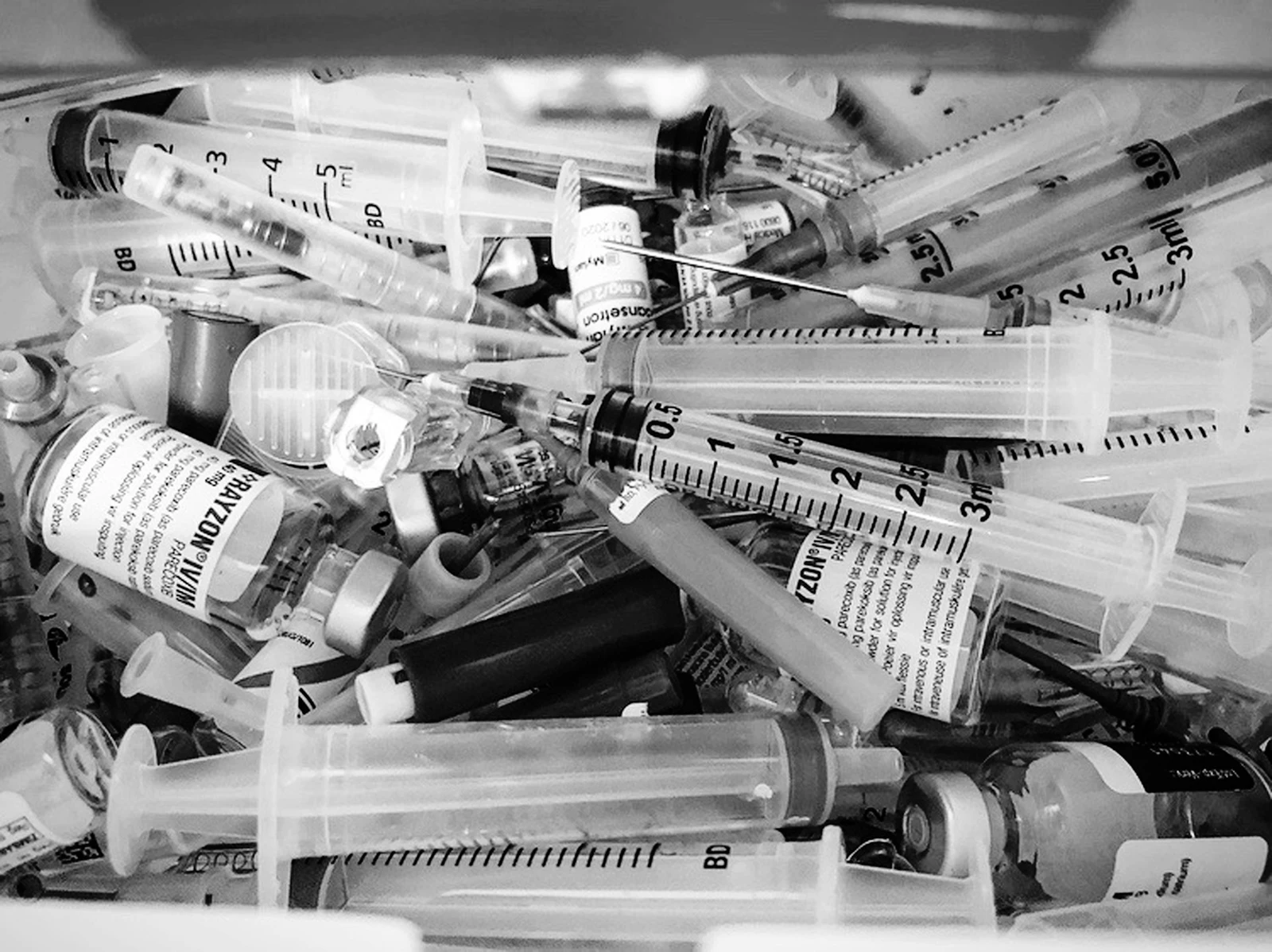
Table of Contents
Key Points
- Some drugs are inherently more addictive than others, though it can vary.
- The consensus is that the most addictive drugs are heroin, alcohol, nicotine, cocaine, and methamphetamine.
- Each of these drugs has different effects and risks.
- Though addiction to certain drugs is known to be challenging, overcoming any addiction can be extremely difficult.
- Addiction treatment is necessary to overcome substance abuse and address the underlying factors for lifelong recovery.
There’s a lot of debate about which drugs are the “most addictive” and why, because there are different factors that affect how drugs impact each individual. Addiction is defined as a compulsive desire to seek out drugs and a pattern of use that negatively impacts health, relationships, or daily life.
According to research from the National Institutes of Health (NIH), about 10% of people in the U.S. have an addiction to drugs or alcohol.[1] Some drugs are considered more addictive because of their effects or how they’re used.
What Is the Most Addictive Drug?
Any drug of abuse can become addictive, as well as some prescription drugs, but there are a few drugs that are widely regarded as being the most addictive:
Heroin
Heroin is a potent opiate that acts on the opioid receptors in the brain. This causes the brain to flood with dopamine, causing euphoria and alleviating pain. The widespread use of prescription opioid painkillers, which are synthetic versions of opiates, has led to an increase in opioid addiction and higher reports of heroin addiction because heroin is more accessible and cheaper than prescription narcotic painkillers.[2] Many people consider opiates like heroin to be the most addictive drugs in existence.
The short-term side effects of heroin are euphoria, pain relief, low appetite, itching, warm skin, dry mouth, vomiting, upset stomach, and a heavy feeling in the arms and legs. Regular use of heroin changes the way your brain works. It can contribute to skin infections, insomnia, collapsed veins, liver and kidney disease, depression, infection in the heart lining and valves, mental illness, lung diseases, and an increased risk of bloodborne illness.[3]
According to the American Society of Addiction Medicine (ASAM), about a quarter of people who use heroin will develop an addiction.[4] Like other drugs of abuse, heroin creates an intense euphoria that fades quickly, encouraging repeated use that builds tolerance and dependence. Heroin and other opiates can have severe withdrawal symptoms as well, leading to relapse.
Alcohol
Alcohol is highly addictive, but it’s unique in that it’s viewed as a socially acceptable substance that’s common in many social events across the world. There’s also a cultural pressure to use alcohol, especially among young people, that can make it difficult to realize the difference between healthy alcohol use and problem use.
Alcohol addiction is known as an alcohol use disorder (AUD). It’s the most common type of substance use disorder. Alcohol is legal and socially acceptable for people over the legal drinking age, which varies by country, and is cheap and accessible. Many people use alcohol responsibly, but that doesn’t mean it’s not addictive. Alcohol impacts the dopamine levels in the brain, creating euphoria in the short term. However, it depresses the central nervous system (CNS), slows cognition, reflexes, and motor skills.
Alcohol has serious risks with chronic use, including severe health effects or lasting changes like poor coordination, mood changes, and poor concentration.[5] Chronic alcohol use has risks to the heart and liver, such as stroke, high blood pressure, arrhythmia, cardiomyopathy, fatty liver, alcoholic hepatitis, and cirrhosis.[6] There’s a toxic effect on the pancreas as well, leading to pancreatitis, a dangerous inflammation of the pancreas that causes swelling and pain.[7]
With heavy, excessive, or binge use, alcohol can cause tolerance and dependence quickly. There’s an additional challenge to breaking the cycle of addiction with alcohol compared to other drugs – it’s widely available and acceptable, often leading to pressure to drink in social situations and stigma around alcohol addiction. Quitting alcohol can be especially difficult because of the intense and potentially life-threatening withdrawal syndrome.
Nicotine
Though nicotine isn’t viewed in the same way as other drugs, it’s one of the most addictive substances in existence. Smoking cigarettes was socially acceptable for decades before the health risks were well understood, and it’s still currently legal for people over 18. However, smoking is the leading cause of preventable disease and death in the U.S..[8]
Nicotine doesn’t impair the brain and body the way alcohol, heroin, or other drugs do, but it still has a powerful effect on the brain’s reward center. The substance is absorbed through the mouth, nose, lungs, and skin, creating a positive mood. The effects come on rapidly but fade in just a few hours, so it can quickly develop into “chain smoking,” or having another cigarette shortly after finishing one. This leads to people smoking multiple packs a day over time.
Considering how quickly smoking causes dependence, nicotine could be considered the most addictive drug that’s legal and accessible, like alcohol. Nicotine also has intense withdrawal that can be difficult to overcome without help.
Cocaine
Cocaine is a powerful stimulant that was once used in medicine, but it’s primarily manufactured and used illicitly in the present. It’s derived from the coca plant in South America and comes in a powder form that can be snorted or injected, or a rock crystal form (crack) that is typically smoked. Crack may be more addictive than powder cocaine, but not because of any chemical difference, but because of the rapid onset of effects from smoking.[9]
Both powder and crack cocaine have effects like excitement and alertness, a “rush” that happens rapidly and fades. This leads to binging to maintain the euphoria, followed by a “crash” that causes strong cravings and depression.
Cocaine is often viewed as a harmless party drug that’s safe when used on occasion, but it’s an addictive and dangerous substance. In the short term, cocaine can cause physical reactions like dilated pupils, an increased heart rate and body temperature, and elevated blood pressure.[10]
A cocaine overdose is possible, as well as long-term health problems from the method of use like asthma and respiratory distress with smoking, infections, bloodborne illness, and collapsed veins with injections, and nosebleeds or loss of smell with snorting.[11]
Methamphetamine
Methamphetamine, or meth, is a potent CNS stimulant that’s primarily manufactured and used illicitly. Like cocaine, it comes in powder or crystal form (crystal meth) that can be smoked, snorted, or injected. Meth is derived from amphetamine and increases alertness and focus with intense euphoria.
There can be unpleasant effects with meth as well, including rapid breathing, racing heart, dry mouth, muscle tension, chest pain, and elevated body temperature that can be stressful.[12] The rush is followed by an intense crash, leading to binge cycles to get the euphoria back. Known as a “comedown,” this may include fatigue, headache, depression, paranoia, sadness, and hunger.[13]
Meth has serious and sometimes irreversible effects on your health in the long term, including dental decay, weight loss, skin itching and sores, memory loss, and a feeling of bugs crawling under the skin.[14] Meth can have permanent effects on the brain’s dopamine system, causing long-term coordination and learning problems or an increased risk of movement disorders.[15]
What Is Addiction?
An addiction is officially known as a substance use disorder. The Diagnostic and Statistical Manual of Mental Disorders (DSM-5) lists specific substance use disorders by the type of drug involved, such as opioid use disorder, stimulant use disorder, or alcohol use disorder, but the criteria are similar:[16]
- Using a substance in larger amounts or for longer periods than intended
- A persistent desire to cut back on substance use without success
- Recurrent substance use that negatively impacts work, school, or home
- Continuing substance use despite persistent or recurrent social or interpersonal problems
- Strong cravings for the substance
Treatment for Substance Use Disorders
Certain substances can have intense or even dangerous withdrawal symptoms that can increase the risk of relapse, including heroin and alcohol. However, any addictive drug can have withdrawal that makes it difficult to quit. Medical detox is often recommended to manage withdrawal symptoms, in case of dangerous withdrawal, to prevent medical complications.
Medical detox also acts as a foundation for addiction treatment. It’s important to transition into a comprehensive addiction treatment program on an inpatient or outpatient basis to address the underlying causes of addiction, not just the physical aspects. Treatment plans are tailored to individual goals and challenges. However, they often combine individual counseling and group counseling with behavioral therapies like cognitive behavioral therapy (CBT) and dialectical behavior therapy (DBT) to understand the motivation behind addiction and develop healthier habits for long-term sobriety.
Find Long-Term Recovery
If you or a loved one is struggling with addiction, it’s best to enter treatment as soon as possible. The highly addictive substances on this list can have serious, long-term health effects or risks, including overdose or permanent changes to the body and brain, that can be prevented with early intervention.
Frequently Asked Questions
Below are some of the most frequently asked questions regarding these two medications.
OCEAN RECOVERY EDITORIAL GUIDELINES
The internet contains a vast amount of misinformation, but when it comes to your health only peer reviewed, research centered data matters. At Ocean Recovery, all content published throughout our website has been rigorously medically reviewed by a doctorate level clinician, and cross checked for medical accuracy. Our editorial process helps our readers trust that the information they are consuming is factual and based upon scientific data. Your health is our top priority, find out more about how we safeguard the integrity of information on our website. Read More About Our Process





